The Quantification of Carbon Emission Factors for Residential Buildings in Yunnan Province
Abstract
:1. Introduction
| Model | Tool | Description | Field | Reference |
|---|---|---|---|---|
| Exponential decomposition method | Dillard and Laplace index methods [6]—LMDI (I and II) | Less requirements, simple, solves 0 and negative problems [7], analyzes direct effects | The influence of economy, energy issues, and factors on changes in energy consumption levels | Reema et al. [9,10,11,12] |
| IPAT series model | STIRPAT model; Kaya | Improved effectiveness and reliability; cannot analyze indirect effects | Quantitative description of human driving force and environmental pressure | Cong et al. [13,14,15,16,17] |
| Structure decomposition method | Tree structure, matrix decomposition, flowchart | Indirect and direct effects can be analyzed | Economic growth factors, labor, prices, energy | Leontief et al. [18,19,20,21] |
2. Methodology
2.1. IPCC Factorial Inventory Method (IPCC-FIM)
2.2. Determination of Carbon Emission Factors
2.3. LMDI Decomposition Method
- Computing method:
- 2.
- Decomposition program:
- 3.
- Aggregate index:
2.4. Evaluated Model of the Carbon Emission Factor
- (1)
- Energy intensity effect, , indicates the impact of the carbon dioxide emission coefficient on carbon emissions. Since the emissions factor of fossil energy in the study remained unchanged, the change generated by this effect was mainly attributed to the change in the annual power carbon emission factor, that is, the change in carbon emissions caused by the factors of power generation efficiency and power generation structure;
- (2)
- Energy structure effect, , indicates the impact of various energy consumption levels on building carbon emissions;
- (3)
- Building area energy intensity, , indicates the change in carbon emissions caused by the energy consumption per unit area;
- (4)
- Per capita building area effect, , indicates the change in building carbon emissions caused by a population increase or decrease per unit of residential building area;
- (5)
- Urbanization effect, , indicates the change in building carbon emissions caused by a city in the process of urbanization;
- (6)
- Population size effect, , indicates the impact of building carbon emissions caused by the factors of population growth or reduction;
2.5. Calculation Method for Carbon Emission Contributions
3. Results and Discussion
3.1. Energy Consumption and Carbon Emissions of RESIDENTIAL BUILDINGS in Yunnan Province
3.2. Quantification of Carbon Emission Factors
- (1)
- Overall, the collective influence of the six factors on the carbon emissions of civil buildings in Yunnan Province predominantly exhibited a promotion rather than inhibition of these emissions. The most significant factor contributing to the reduction in carbon emissions from these residential buildings was the energy intensity effect, registering a cumulative contribution value of −4.71 MTCO2 (million tons of carbon dioxide) in 2019, equating to a cumulative contribution of 214%.
- (2)
- The primary factors that positively contributed to the increase in carbon emissions from residential buildings were the per capita floor area, followed by the energy intensity of the floor area, with the population size exerting the least influence.
- (3)
- The main factors that inhibited the carbon emissions growth of residential buildings were energy intensity, followed by energy structure, and finally, urbanization.
- (1)
- In summary, the factors influencing the variation in carbon emissions from residential buildings in Yunnan Province include the energy intensity effect of the building area and the energy intensity effect. Both the energy intensity effect and energy structure’s impact are inhibitory in both urban and rural residential buildings. Notably, the energy effect of the floor area plays a contrasting role in urban residential buildings compared to rural residential buildings.
- (2)
- Figure 10 illustrates that the comprehensive impact of influencing factors on urban residential buildings, obtained with the additive decomposition method, exhibits a U-shaped pattern in its effect on carbon emissions.
- (3)
- The cumulative contribution rates of the six influencing factors can be determined as follows: urban building carbon emissions exhibit a negative correlation with the energy consumption per unit area, energy intensity effect, and energy structure effect, as depicted in Figure 11, with contribution rates of 0.34, 0.27, and 0.05, respectively. In contrast, it demonstrates a positive correlation with the per capita construction area, urbanization rate, and population size, with contribution rates of 0.23, 0.11, and 0.01, respectively.
- (4)
- For rural residential buildings, the comprehensive effect of the factors obtained using the addition decomposition method presents an inverted “M”-type change in carbon emissions levels. The reasons for this phenomenon are as follows: the most significant factor inhibiting the growth of carbon emissions is the urbanization effect, which contributes −2MTCO2 at a contribution rate of −168.77%. The per capita floor area and energy intensity effect of the floor area play a major role in promoting the carbon emissions from buildings, contributing 2.46MTCO2 in the period from 2010 to 2019, and the cumulative contribution rate was 72.89%. According to Equations (11) and (12), the cumulative contribution rates of the six influencing factors can be successfully obtained. The urbanization rate, energy intensity effect, and energy structure effect are negatively correlated, and, as shown in Figure 11, the contribution rates are 0.16, 0.15, and 0.14, respectively. On the contrary, they are positively correlated with the per capita building area, energy consumption per unit area, and population size, with contribution rates of 0.29, 0.24, and 0.02, respectively.
3.3. Disscussion
4. Conclusions
- The main factors influencing carbon emissions in residential buildings include the per capita floor area, energy consumption per unit area, energy intensity effect, energy structure effect, urbanization rate, and population size.
- For different types of residential buildings, due to different energy use structures, different factors have different influence trends and ranges on different types of buildings, and the same influencing factors also play different roles. Among them, the overall factors that play a role in promoting carbon emissions, ranging from highest to lowest, are the per capita floor area, energy consumption per unit area, and population size, and the influencing factors that play a role in inhibiting carbon emissions, ranging from highest to lowest are the energy intensity effect, energy structure effect, and effect of urbanization.
- Among the abovementioned influencing factors, carbon emissions from urban buildings can be negatively correlated with the energy consumption per unit area, energy intensity benefit, and energy structure effect, and their contribution degrees are 0.34, 0.27, and 0.05, respectively. The effects of per capita floor area, urbanization, and population size are positively correlated, and their contribution degrees are 0.23, 0.11, and 0.01, respectively.
- Carbon emissions in rural buildings are negatively correlated with the effects of urbanization, energy intensity benefits, and energy structure, and their contribution degrees are 0.16, 0.15, and 0.14, respectively. Per capita floor area, energy consumption per unit area, and population size effects were positively correlated, and their contribution degrees were 0.29, 0.24, and 0.02, respectively.
- When quantifying carbon emissions, the energy balance table can be used to perform the calculations, which may overlook the real building energy consumption values. In the future, with the improvement of technology, more appropriate research data can be used. More than one method was available for selecting the appropriate influencing factors in this study, and other methods can be used to determine the relevant influencing factors in the future.
Author Contributions
Funding
Data Availability Statement
Conflicts of Interest
Abbreviations
| IPCC-FIM | IPCC factorial inventory method |
| IPAT | Regarding environmental impact (I), population (P), affluence (A), and technology (T) |
| LMDI | Logarithmic mean Divisia index decomposition method |
| SDA | Structure decomposition analysis |
| GHG | Greenhouse gas |
| C | Total carbon emissions of all types of buildings |
| E | The total energy consumption of all types of buildings |
| Energy structure effect (z represents urban; r represents rural) | |
| Building area energy intensity (z represents urban; r represents rural) | |
| Per capita building area effect (z represents urban; r represents rural) | |
| Urbanization effect (z represents urban; r represents rural) | |
| Population size effect (z represents urban) | |
| S | Floor area |
| P | Population size effect |
| STIRPAT | An extension of the IPAT model |
| Carbon dioxide emissions coefficient of i energy, that is, the energy intensity effect | |
| Proportion of I energy in building energy consumption, that is, the effect of the energy structure | |
| Energy consumption per unit building area, that is, energy intensity effect of the building area | |
| Represents the per capita living area, that is, the per capita building area effect | |
| Proportion of urban and rural populations in the total population, that is, the urbanization effect | |
| Total carbon emissions | |
| Carbon emissions from the base period | |
| Carbon emissions in period t | |
| Energy intensity effect (z represents urban; r represents rural) |
References
- Li, R. Low-carbon economy and sustainable economic development in China. Soc. Sci. 2009, 47–50. [Google Scholar]
- Hu, Y.; Zhu, D. Decoupling analysis of CO2 emissions from output value and energy consumption in China’s construction industry. China Popul. Resour. Environ. 2015, 25, 50–57. [Google Scholar]
- Ma, X.; Ouyang, Q. Construction of the industrial structure adjustment based on carbon emissions research. Ecol. Econ. 2016, 32, 5. [Google Scholar] [CrossRef]
- National Development and Reform Commission Energy Research Institute. Reinventing Energy: A roadmap for China’s Energy Consumption and Production Revolution to 2050. Econ. Res. 2016, 3–14. [Google Scholar] [CrossRef]
- Liu, T.; Wu, Z.; Chen, C.; Chen, H.; Zhou, H. Carbon Emission Accounting during the Construction of Typical 500 kV Power Transmissions and Substations Using the Carbon Emission Factor Approach. Buildings 2024, 14, 145. [Google Scholar] [CrossRef]
- Ang, B.W. LMDI decomposition approach: A guide for implementation. Energy Policy 2015, 86, 233–238. [Google Scholar] [CrossRef]
- de Freitas, L.C.; Kaneko, S. Decomposing the decoupling of CO2 emissions and economic growth in Brazil. Ecol. Econ. 2011, 70, 1459–1469. [Google Scholar] [CrossRef]
- Gao, H.; Wang, X.; Wu, K.; Zheng, Y.; Wang, Q.; Shi, W.; He, M. A Review of Building Carbon Emission Accounting and Prediction Models. Buildings 2023, 13, 1617. [Google Scholar] [CrossRef]
- Alajmi, R.G. Factors that impact greenhouse gas emissions in Saudi Arabia: Decomposition analysis using LMDI. Energy Policy 2021, 156, 112454. [Google Scholar] [CrossRef]
- Shi, L.; Sun, J.; Lin, J.; Zhao, Y. Factor decomposition of carbon emissions in Chinese megacities. J. Environ. Sci. 2019, 75, 209–215. [Google Scholar] [CrossRef]
- Chong, C.; Ma, L.; Li, Z.; Ni, W.; Song, S. Logarithmic mean Divisia index (LMDI) decomposition of coal consumption in China based on the energy allocation diagram of coal flows. Energy 2015, 85, 366–378. [Google Scholar] [CrossRef]
- Ang, B.W. The LMDI approach to decomposition analysis: A practical guide. Energy Policy 2005, 33, 867–871. [Google Scholar] [CrossRef]
- Cong, X.; Zhao, M.; Li, L. Analysis of Carbon Dioxide Emissions of Buildings in Different Regions of China Based on STIRPAT Model. Procedia Eng. 2015, 121, 645–652. [Google Scholar] [CrossRef]
- Ma, M.; Yan, R.; Cai, W. An extended STIRPAT model-based methodology for evaluating the driving forces affecting carbon emissions in existing public building sector: Evidence from China in 2000–2015. Nat. Hazards 2017, 89, 741–756. [Google Scholar] [CrossRef]
- Wang, P.; Wu, W.; Zhu, B.; Wei, Y. Examining the impact factors of energy-related CO2 emissions using the STIRPAT model in Guangdong Province, China. Appl. Energy 2013, 106, 65–71. [Google Scholar] [CrossRef]
- Ehrlich, P.R.; Holdren, J.P. Impact of Population Growth. Obstet. Gynecol. Surv. 1971, 26, 769–771. [Google Scholar] [CrossRef]
- Dietz, T.; Rosa, E.A. Rethinking the Environmental Impacts of Population. Affluence and Technology. Hum. Ecol. Rev. 1994, 1, 277–300. [Google Scholar]
- Su, B.; Ang, B.W.; Li, Y. Input-output and structural decomposition analysis of Singapore’s carbon emissions. Energy Policy 2017, 105, 484–492. [Google Scholar] [CrossRef]
- Su, B.; Ang, B.W. Multi-region comparisons of emission performance: The structural decomposition analysis approach. Ecol. Indic. 2016, 67, 78–87. [Google Scholar] [CrossRef]
- Su, B.; Ang, B.W.; Low, M. Input–output analysis of CO2 emissions embodied in trade and the driving forces: Processing and normal exports. Ecol. Econ. 2013, 88, 119–125. [Google Scholar] [CrossRef]
- Wood, R. Structural decomposition analysis of Australia’s greenhouse gas emissions. Energy Policy 2009, 37, 4943–4948. [Google Scholar] [CrossRef]
- Xia, Q.; Li, S.; Tao, D. Research on Influencing Factors of carbon Emission from Construction industry in China based on Extended STIRPAT Model. Manag. Mod. 2017, 37, 3. [Google Scholar]
- Sun, Y.; Zhou, M. Decoupling of carbon emissions from Energy Consumption and economic growth in China and its driving factors. Econ. Manag. Rev. 2017, 21–30. [Google Scholar] [CrossRef]
- Tseng, S. Analysis of Energy-Related Carbon Emissions in Inner Mongolia, China. Sustainability 2019, 11, 7008. [Google Scholar] [CrossRef]
- Guofa. Notice of The State Council on Printing and Distributing the Comprehensive Work Plan for Energy Conservation and Emission Reduction for the 13th Five-Year Plan Period; No.74.2017-01-05; Guofa: Jinjiang, China, 2016. [Google Scholar]
- Department of Housing and Urban-Rural Development of Yunnan Province. Some Measures to Promote the High-Quality Development of Construction Industry in Yunnan Province; Department of Housing and Urban-Rural Development of Yunnan Province: Beijing, China, 2022. [Google Scholar]
- General Office of the CPC Central Committee, Notice on Accelerating the promotion of Green Buildings. 2021. Available online: https://www.gov.cn/ (accessed on 21 October 2021).
- Huo, T.; Ren, H.; Zhang, X.; Cai, W.; Feng, W.; Zhou, N.; Wang, X. China’s energy consumption in the building sector: A Statistical Yearbook-Energy Balance Sheet based splitting method. J. Clean. Prod. 2018, 185, 665–679. [Google Scholar] [CrossRef]
- Aunedi, M.; Olympios, A.V.; Pantaleo, A.M.; Markides, C.N.; Strbac, G. System-driven design and integration of low-carbon domestic heating technologies. Renew. Sustain. Energy Rev. 2023, 187, 113695. [Google Scholar] [CrossRef]
- Donglan, Z.; Dequn, Z.; Peng, Z. Driving forces of residential CO2 emissions in urban and rural China: An index decomposition analysis. Energy Policy 2010, 38, 3377–3383. [Google Scholar] [CrossRef]
- Ozdemir, A.C. Decomposition and decoupling analysis of carbon dioxide emissions in electricity generation by primary fossil fuels in Turkey. Energy 2023, 273, 127264. [Google Scholar] [CrossRef]
- Dong, J.; Li, C.; Wang, Q. Decomposition of carbon emission and its decoupling analysis and prediction with economic development: A case study of industrial sectors in Henan Province. J. Clean. Prod. 2021, 321, 129019. [Google Scholar] [CrossRef]
- Gu, S.; Fu, B.; Thriveni, T.; Fujita, T.; Ahn, J.W. Coupled LMDI and system dynamics model for estimating urban CO2 emission mitigation potential in Shanghai, China. J. Clean. Prod. 2019, 240, 118034. [Google Scholar] [CrossRef]
- Song, M.; Guo, X.; Wu, K.; Wang, G. Driving effect analysis of energy-consumption carbon emissions in the Yangtze River Delta region. J. Clean. Prod. 2015, 103, 620–628. [Google Scholar] [CrossRef]
- Wu, L.; Zeng, W. Research on the Contribution of Structure Adjustment on Carbon Dioxide Emissions Reduction based on LMDI Method. Procedia Comput. Sci. 2013, 17, 744–751. [Google Scholar] [CrossRef]
- Neumayer, E.; Cole, M.A. Examining the Impact of Demographic Factors on Air Pollution. Popul. Environ. 2004, 26, 5–21. [Google Scholar]
- Rosa, E.A.; York, R.; Dietz, T. Tracking the anthropogenic drivers of ecological impacts. Ambio 2004, 33, 509–512. [Google Scholar] [CrossRef] [PubMed]
- Zhu, Q.; Peng, X. The impacts of population change on carbon emissions in China during 1978–2008. Environ. Impact Assess. Rev. 2012, 36, 1–8. [Google Scholar] [CrossRef]
- Ren, S.; Yin, H.; Chen, X. Using LMDI to analyze the decoupling of carbon dioxide emissions by China’s manufacturing industry. Environ. Dev. 2014, 9, 61–75. [Google Scholar] [CrossRef]
- Zhu, Q.P.X.Z.; Zhu, Q.; Peng, X.Z.; Lu, Z.M.; Wu, K.Y. Factors decomposition and empirical analysis of variations in energy carbon emission in China. Resour. Sci. 2009, 31, 2072–2079. [Google Scholar]
- Wang, Y.; Jiang, Z.; Li, L.; Qi, Y.; Sun, J.; Jiang, Z. A Bibliometric and Content Review of Carbon Emission Analysis for Building Construction. Buildings 2023, 13, 205. [Google Scholar] [CrossRef]
- Lin, B.; Ouyang, X. Analysis of energy-related CO2 (carbon dioxide) emissions and reduction potential in the Chinese non-metallic mineral products industry. Energy 2014, 68, 688–697. [Google Scholar] [CrossRef]
- Zhang, Y.; Da, Y. The decomposition of energy-related carbon emission and its decoupling with economic growth in China. Renew. Sustain. Energy Rev. 2015, 41, 1255–1266. [Google Scholar] [CrossRef]
- Wang, W.; Kuang, Y.; Huang, N. Study on the Decomposition of Factors Affecting Energy-Related Carbon Emissions in Guangdong Province, China. Energies 2011, 4, 2249–2272. [Google Scholar] [CrossRef]
- Yang, J.; Chen, B. Using LMDI method to analyze the change of industrial CO2 emission from energy use in Chongqing. Front. Earth Sci. 2011, 5, 103–109. [Google Scholar] [CrossRef]
- Ang, B.W.; Zhang, F.Q. A survey of index decomposition analysis in energy and environmental studies. Energy 2000, 25, 1149–1176. [Google Scholar] [CrossRef]
- Boyd, G.; McDonald, J.F.; Ross, M.; Hanson, D.A. Separating the Changing Composition of U.S. Manufacturing Production from Energy Efficiency Improvements: A Divisia Index Approach. Energy J. 1987, 8, 77–96. [Google Scholar] [CrossRef]
- Ang, B.W.; Liu, F.L. A new energy decomposition method: Perfect in decomposition and consistent in aggregation. Energy 2001, 26, 537–548. [Google Scholar] [CrossRef]
- Ang, B.W.; Zhang, F.Q.; Choi, K. Factorizing changes in energy and environmental indicators through decomposition. Energy 1998, 23, 489–495. [Google Scholar] [CrossRef]
- Wang, W.; Liu, X.; Zhang, M.; Song, X. Using a new generalized LMDI (logarithmic mean Divisia index) method to analyze China’s energy consumption. Energy 2014, 67, 617–622. [Google Scholar] [CrossRef]
- Wang, G.; Chen, X.; Zhang, Z.; Niu, C. Influencing Factors of Energy-Related CO2 Emissions in China: A Decomposition Analysis. Sustainability 2015, 7, 14408–14426. [Google Scholar] [CrossRef]
- Wang, Q.; Li, R.; Jiang, R. Decoupling and Decomposition Analysis of Carbon Emissions from Industry: A Case Study from China. Sustainability 2016, 8, 1059. [Google Scholar] [CrossRef]
- Xiao, B.; Niu, D.; Guo, X. The Driving Forces of Changes in CO2 Emissions in China: A Structural Decomposition Analysis. Energies 2016, 9, 259. [Google Scholar] [CrossRef]
- Energy Bureau Website. National Energy Bureau on the Issuance of 2016 Energy Work Guidance Notice National Energy Planning. Available online: http://zfxxgk.nea.gov.cn/ (accessed on 12 April 2016).
- General Office of the CPC. Central Committee and General Office of the State Council. Opinions on Promoting Green Development of Urban and Rural Construction; General Office of the CPC: Beijing, China, 2021. [Google Scholar]
- Ministry of Finance; Ministry of Housing and Urban-Rural Development. Notice of Urban Demonstration Implementation Plan for Renewable Energy Building Applications; Caijian: Beijing, China, 2009. [Google Scholar]
- Guofa. Notice of The State Council on Printing and Distributing the Comprehensive Work Plan for Energy Conservation and Emission Reduction for the 14th Five-Year Plan; Guofa: Jinjiang, China, 2021. [Google Scholar]
- National Development and Reform Commission; Ministry of Science and Technology; Ministry of Industry and Information Technology; Ministry of Finance; Natural Resources; Housing and Urban-Rural Development; Ministry of Transport; SASAC of The State Council, National Energy Administration. Green low-Carbon Advanced Technology Demonstration Project Implementation Plan. [2023] 1093 [Z]. Available online: https://www.gov.cn/ (accessed on 23 August 2023).
- Department of Industry and Information Technology of Yunnan Province. Yunnan Province Industrial Energy Efficiency Improvement Action Plan (2019–2020). Cloud Industry and Information Technology Energy Conservation; Department of Industry and Information Technology of Yunnan Province: Beijing, China, 2019. [Google Scholar]


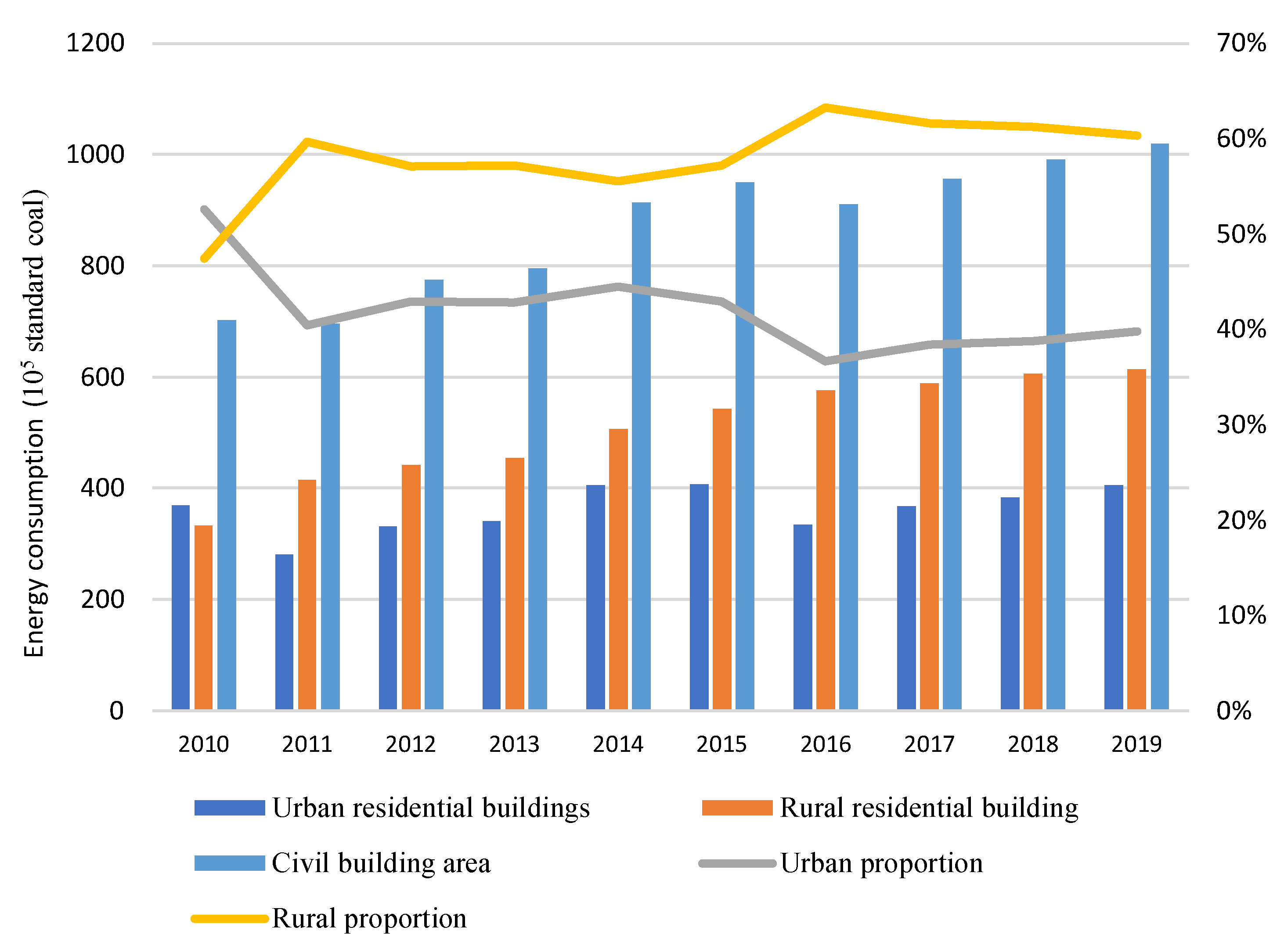
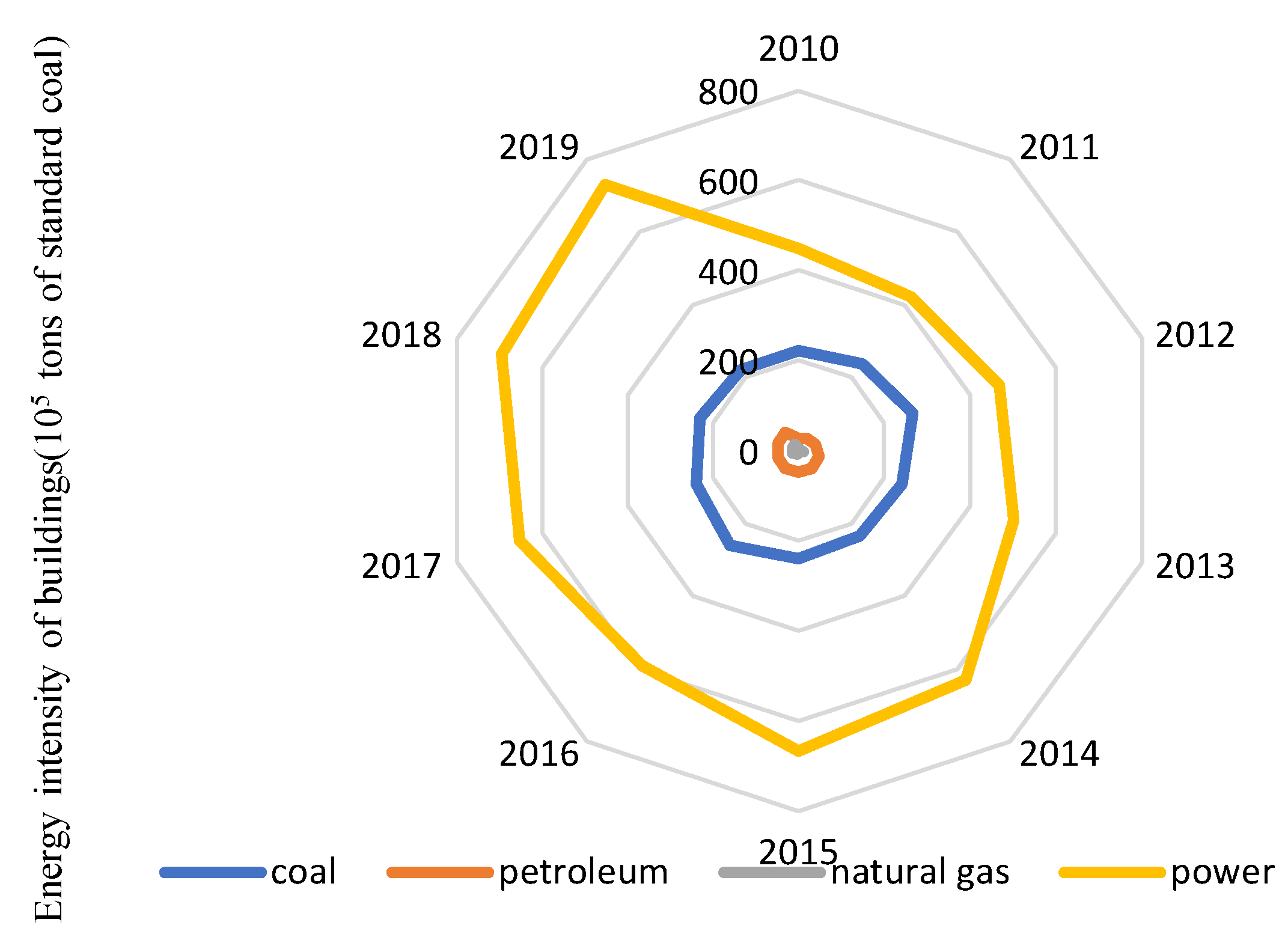
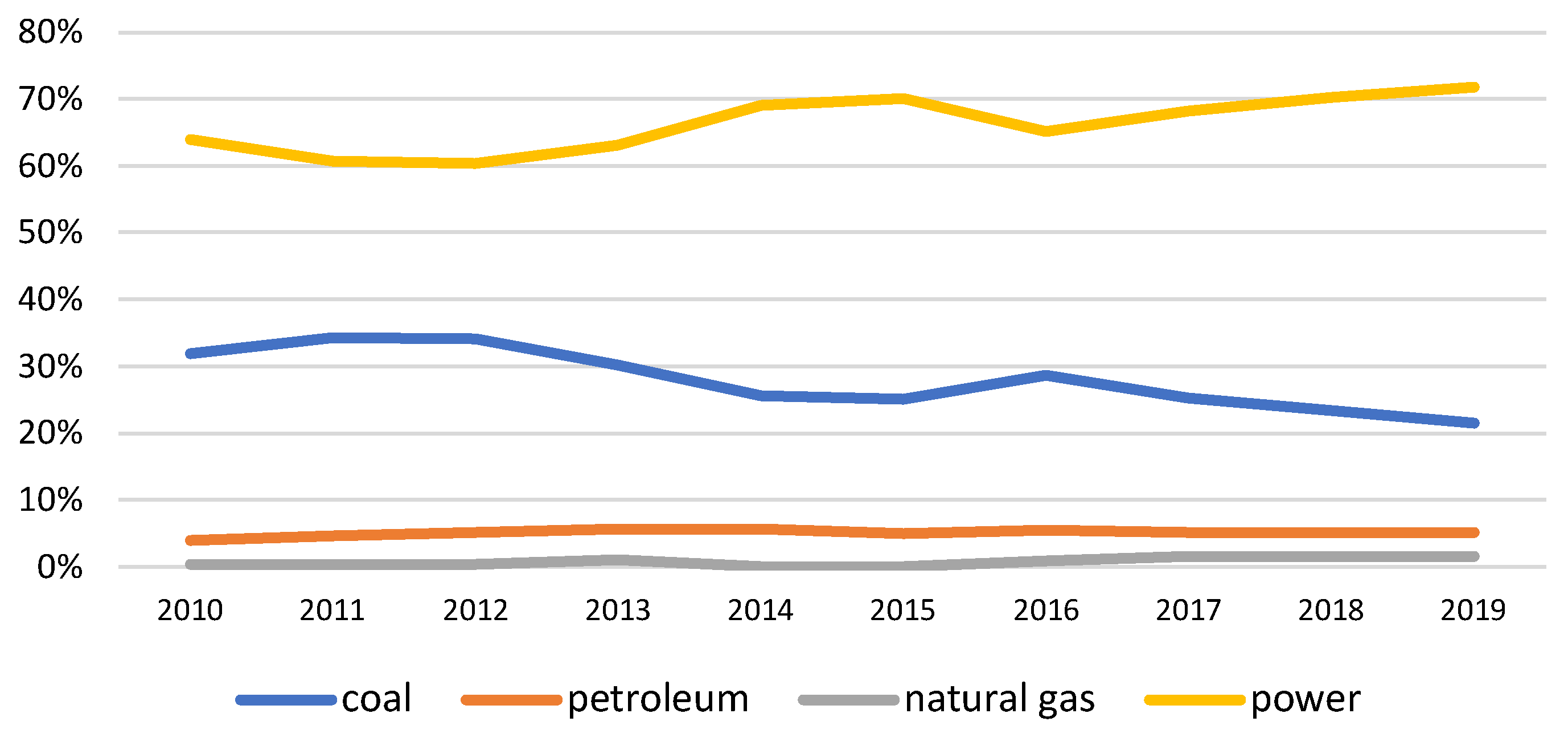


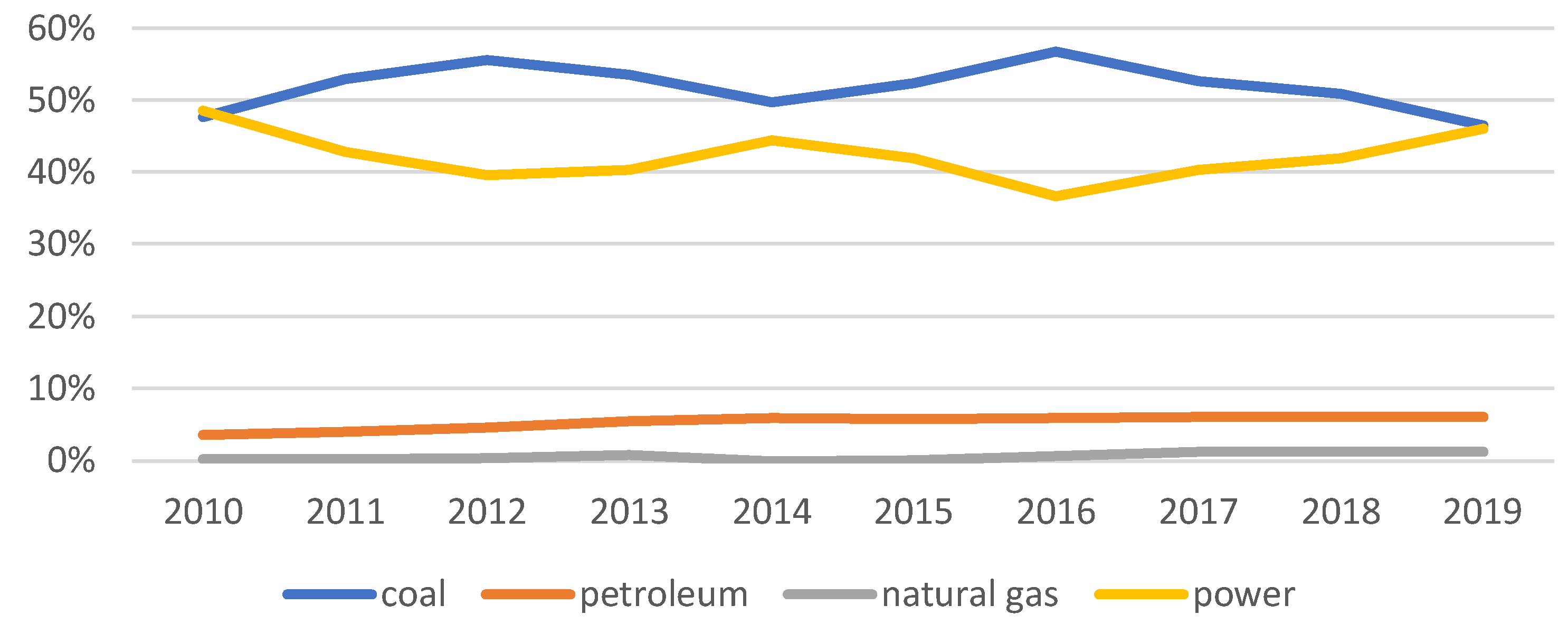

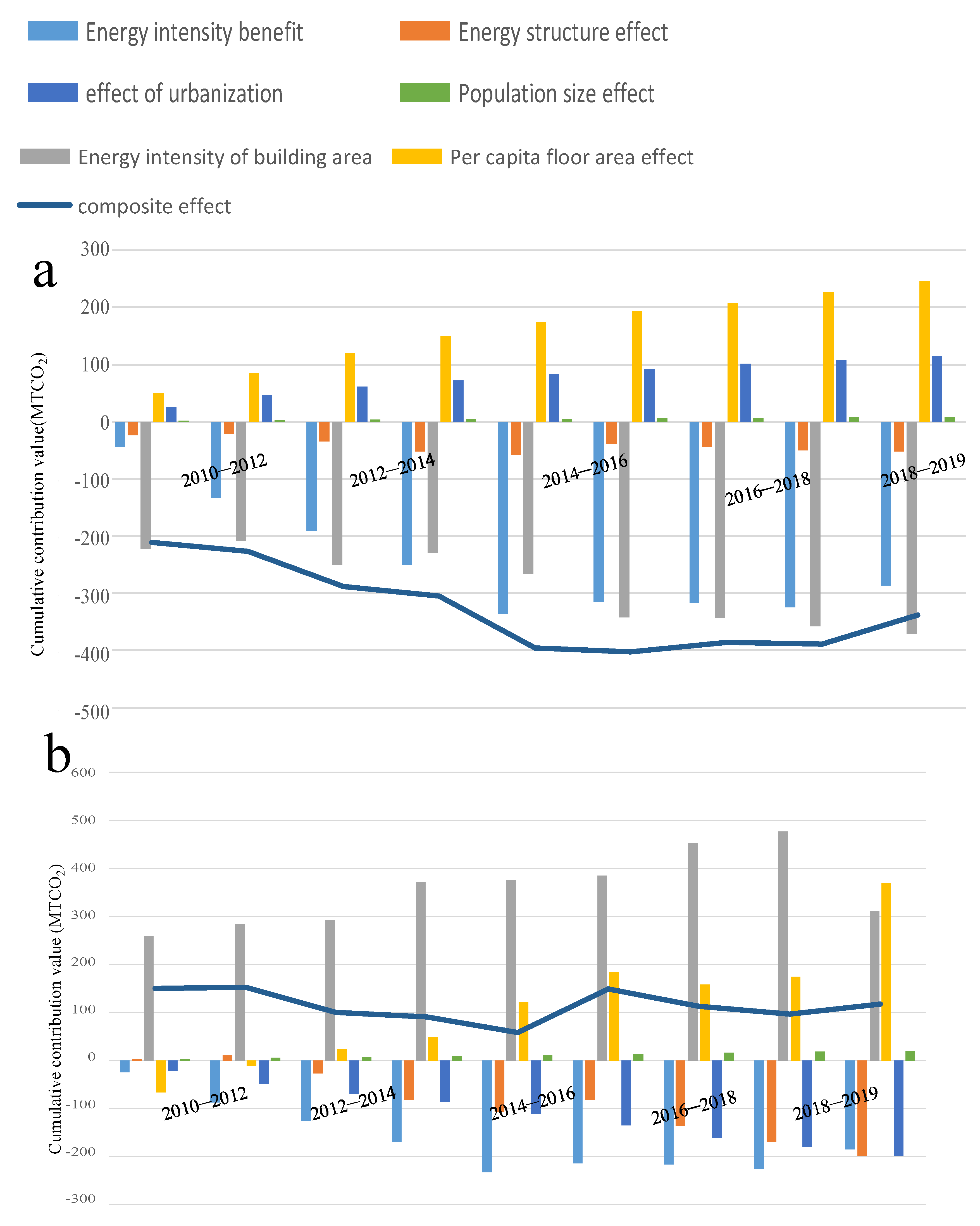

| Method | Formula | Features | Input |
|---|---|---|---|
| IPCC-FIM | Em = AD × EF Em—greenhouse gas emissions, AD—activity data, EF—emission factor | Simple, practical, and applicable; carbon emission factors are regional | Emission factors; activity levels |
| Material balance method | ΣGinput = ΣGproduct + ΣGlose Ginput—total, input material, Gproduct—obtain the sum of the product quantities, Glose—total amount of material and product lost | Reflects the actual emissions, there are errors, the workload is large | Introduces new chemical qualities; facility or equipment storage |
| Field measurement method | G = KQC G—emission of a gas, Q—flow medium, C—concentration of a gas in a medium, K—unit conversion coefficient | Accurate results and high cost | Air flow; conversion coefficient; emission concentration |
| Key Factors Affecting Building Carbon Emissions | Key Factors Affecting the Carbon Emissions of Residential Buildings |
|---|---|
| Energy | Energy structure |
| Energy intensity | |
| Social development | Population size |
| Urbanization | |
| Architecture | Energy consumption per unit area |
| Per capita floor area |
| Variable | Definition |
|---|---|
| Total carbon emissions for all types of buildings | |
| Total energy consumption for all types of buildings | |
| Floor area | |
| Population size effect | |
| Carbon dioxide emission coefficient of i energy, that is, the energy intensity effect | |
| Represents the proportion of i energy in building energy consumption, that is, the effect of the energy structure | |
| Represents energy consumption per unit building area, that is, the energy intensity effect of a building area | |
| Represents the per capita living area, that is, the per capita building area effect | |
| Proportion of urban and rural populations in the total population, that is, the urbanization effect |
| Year | Urban Residential Buildings | Urban Proportion | Rural Residential Buildings | Rural Proportion | Civil Building Area |
|---|---|---|---|---|---|
| 2010 | 6.45 | 34% | 12.49 | 66% | 18.94 |
| 2011 | 7.49 | 40% | 11.23 | 60% | 18.71 |
| 2012 | 8.57 | 42% | 11.63 | 58% | 20.21 |
| 2013 | 9.81 | 45% | 11.86 | 55% | 21.67 |
| 2014 | 11.04 | 48% | 12 | 52% | 23.04 |
| 2015 | 12.54 | 50% | 12.78 | 50% | 25.32 |
| 2016 | 14.19 | 51% | 13.41 | 49% | 27.6 |
| 2017 | 15.67 | 55% | 12.67 | 45% | 28.35 |
| 2018 | 17.32 | 58% | 12.66 | 42% | 29.98 |
| 2019 | 19.12 | 55% | 15.68 | 45% | 34.79 |
Disclaimer/Publisher’s Note: The statements, opinions and data contained in all publications are solely those of the individual author(s) and contributor(s) and not of MDPI and/or the editor(s). MDPI and/or the editor(s) disclaim responsibility for any injury to people or property resulting from any ideas, methods, instructions or products referred to in the content. |
© 2024 by the authors. Licensee MDPI, Basel, Switzerland. This article is an open access article distributed under the terms and conditions of the Creative Commons Attribution (CC BY) license (https://creativecommons.org/licenses/by/4.0/).
Share and Cite
Li, W.; Li, Q.; Zhang, C.; Jin, S.; Wang, Z.; Huang, S.; Deng, S. The Quantification of Carbon Emission Factors for Residential Buildings in Yunnan Province. Buildings 2024, 14, 880. https://doi.org/10.3390/buildings14040880
Li W, Li Q, Zhang C, Jin S, Wang Z, Huang S, Deng S. The Quantification of Carbon Emission Factors for Residential Buildings in Yunnan Province. Buildings. 2024; 14(4):880. https://doi.org/10.3390/buildings14040880
Chicago/Turabian StyleLi, Wuyan, Qinyao Li, Chubei Zhang, Sike Jin, Zhihao Wang, Sheng Huang, and Shihan Deng. 2024. "The Quantification of Carbon Emission Factors for Residential Buildings in Yunnan Province" Buildings 14, no. 4: 880. https://doi.org/10.3390/buildings14040880






